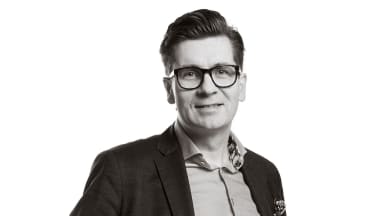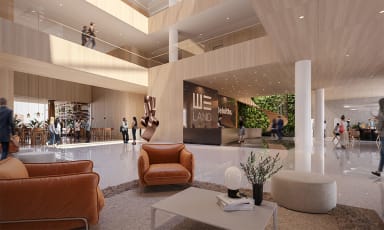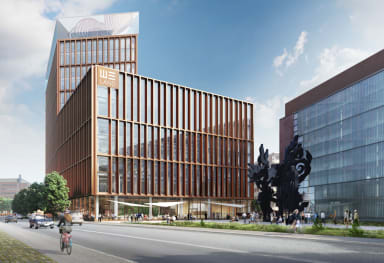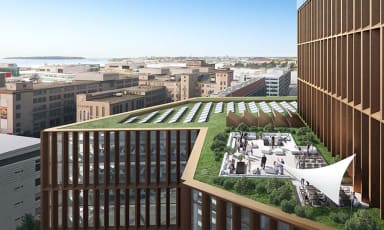We Land Helsinki: One thing above all attracts property investors and tenants
”ESG is increasing in focus where property investments are concerned. Today, preference is given to property portfolios with a strong commitment to sustainability values. One could even say that a new building project without the environmental certificate hardly attracts investor interest which is why the investment is not realised,” Senior Property Developer Heikki Alén says.
Sustainability drives property development both in investor portfolios and tenant choices. NCC’s development project We Land in Ruoholahti, Helsinki makes history while still under construction: it is the first project in Finland to be certified to level Outstanding, the highest BREEAM environmental rating.
”We Land is the forefront of sustainable construction. Not often do you come across BREEAM environmental rating and its level Outstanding even on the international scale, but it’s becoming all more relevant when you come to think of the building’s attractive power and secondary market value,” Alén explains.

”Attractive to tenant, attractive to investor”
”Sustainability is an interest that both the tenants and the investors share. When the company is looking for headquarters-level office space, it is one of the key criteria for making the decision. We are witnessing a positive chain reaction: what is attractive to the tenant is also attractive to the investor,” Alén confirms.
Likewise, the employees are increasingly looking for companies to suit their own values. Sustainability is a recruitment trump card and improves job well-being. In addition, the targets set by cities for carbon emissions are getting stricter all the time, which is seen in the town-planning and permitting process.
We Land supports Deloitte’s strategy
Less than five per cent are indifferent to sustainability
According to Alén, there has been a huge and quick rise in the appreciation of sustainability. When the development of We Land was first launched in 2018, approximately five per cent of office tenants were looking into the property’s sustainability. Since then, the share of those indifferent to the matter has probably dropped below five per cent.
”You can tell by the design of electric vehicle charging stations that the change has been quick: in 2018, the demand was estimated generally at 20 per cent, but we were brave enough to go for 100 per cent. There can hardly be any excess at the moment of completion in spring 2024.”
Sustainability is built on many different features that the property developer brings together, such as the site and its location, the traffic connections and the rest of the built environment, including services. A property developer today will be contemplating over matters of energy supply in 2030, but also the building’s material efficiency, carbon footprint, service technology, modifiability and employee well-being.

”A property developer works for tomorrow’s value set”
The BREEAM ratings are developing continuously. The bar will be raised even higher which will work as a catalyst to improving sustainability of property development. Property developers play overall an important role here, because they must be able to predict the future for a long time ahead.
”At the point when we start working on a new development project we neither have the investors nor the tenants. Our work is based on assumptions that help us predict how the building should be, say, in five years’ time, even after ten years of operation. We are working for the future demand and value set,” Alén describes.
NCC uses BREEAM as an established process and an in-built policy ten years already. The highest ratings require a multi-disciplinary team who are familiar with the hundreds of details that the certificate covers. The foundation for building a carbon neutral Finland is laid on a designer’s workdesk.

”Activity is taken deeper than the surface, reaching even higher”
Environmental Consultant Karoliina Lietonen of Sweco Talotekniikka Oy from the team specialising in carbon footprint calculation and certification of built environment participates in the design of We Land since the beginning. According to Lietonen, the advanced activity is taken deeper than the surface, reaching even higher.
”All activity is steered by the application for the higher rating. The certificate sets minimum requirements, in addition to which project-specific targets are selected. A property developer can set targets that exceed the requirements of current national and EU legislation,” Lietonen explains.
The cornerstone ceremony of We Land took place in January 2022. Although the new building site looks more like a pit at the moment, the sustainability targets are already considered in the temporary arrangements of the building site, such as the sole use of emission-free power supply, minimising construction waste and site transportation emissions and giving preference to recyclable materials whenever possible.
”We Land is the forefront of sustainability where material efficiency and life-cycle thinking are concerned. The façade is a great example of this, because it’s built from recycled and yet recyclable copper. Positive BREEAM points are also earned owing to the green roof, the roof garden and solar panels,” Lietonen adds.

